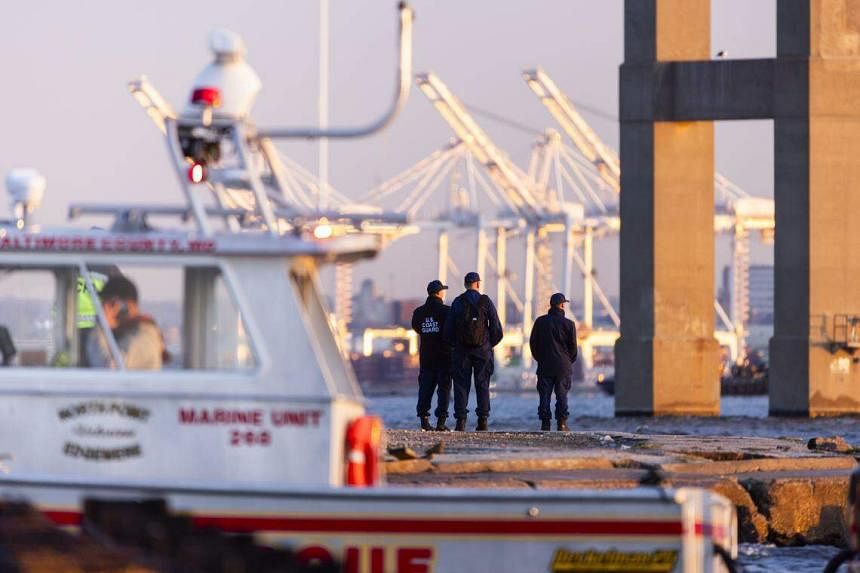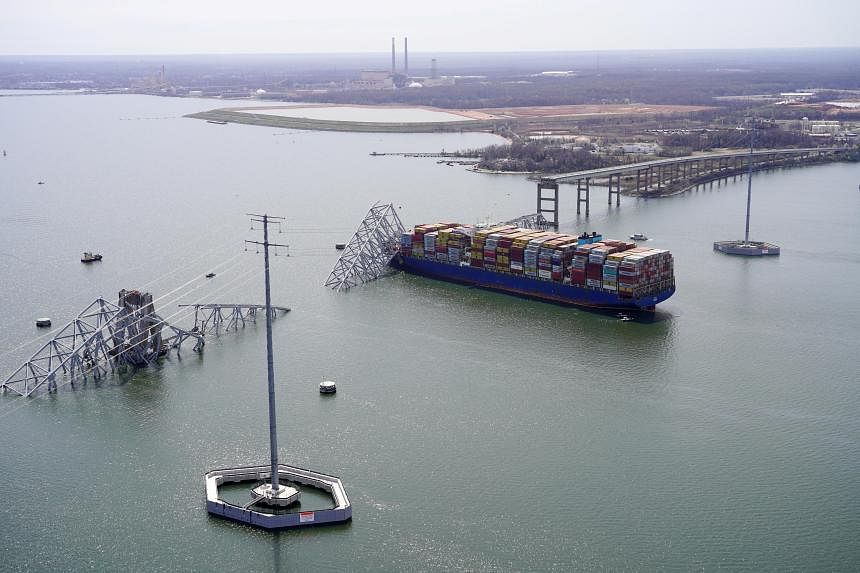MARYLAND – Rescuers have lost hope of finding more survivors of the Baltimore bridge collapse, as efforts switched on March 27 to looking for the bodies of the missing and more answers to what caused a massive cargo ship to smash into the span.
“At this point, we do not believe that we’re going to find any of these individuals alive,” Rear-Admiral Shannon Gilreath of the US Coast Guard said at a news briefing, citing the cold water temperatures and the length of time since the overnight collapse.
He said responders were transitioning “to a different phase”.
Speaking at the same briefing, Maryland secretary of state police Roland Butler said the focus would shift to a “recovery operation”.
Baltimore Mayor Brandon Scott said rescue workers from federal, state and city agencies were still searching the waters surrounding the twisted ruins of the bridge knocked down in Baltimore Harbour by a faltering cargo ship, leaving six construction workers missing and presumed dead.
Speaking to local television station WJZ-TV early on March 27, Mr Scott said the rescue workers were hoping to find the victims so their families could have “closure”.
“We know that they know they will not be coming back alive,” he said.
Maryland Governor Wes Moore said divers were dealing with tremendously dangerous conditions.
“We’re talking about frigid temperatures. We’re talking about a moving tide. We’re talking about darkness and mangled metal,” he said in an interview with CBS News.
Rescuers pulled two other workers from the water alive on March 26, and one of them was hospitalised. The six presumed to have perished included workers from Mexico, Guatemala and El Salvador.

Officials said all eight were part of a work crew repairing potholes on Francis Scott Key Bridge’s road surface when the Singapore-flagged container vessel Dali, leaving Baltimore for Sri Lanka, ploughed into a support pylon of the bridge at about 1.30am (local time).
A trestled section of the 2.6km span almost immediately crumpled into the icy water, sending vehicles and workers into the river.
Search for answers
The National Transportation Safety Board (NTSB) on March 27 began what could be a long search for answers.
The agency’s investigators had boarded the Dali, recovered its data recorder and interviewed its crew.
They will focus on several lines of inquiry, including what Dali’s recorder shows and what exactly caused an apparent system failure on board the ship, said NTSB chair Jennifer Homendy.
“Right now, we do have the data recorder, which is essentially the black box,” she told CNN.
“We’ve sent that back to the lab to evaluate and begin to develop a timeline of events that led up to the strike on the bridge.”
She said investigators would examine whether what they called dirty fuel played a role in the ship’s power loss.
They would also review the results of past inspections.
Singapore’s Transport Minister Chee Hong Tat said in a post on Facebook on March 27 that he had written to US Transportation Secretary Pete Buttigieg “to reaffirm Singapore’s commitment to render assistance”.
“As a flag state, our officers will work closely with the US Coast Guard and agencies to fully support the investigations,” said Mr Chee.
The Dali reported a loss of propulsion shortly before impact and dropped anchor to slow the vessel, giving transportation officials time to halt traffic on the bridge before the crash. That move likely prevented a higher death toll, the authorities said.
It was unclear whether the work crew was alerted ahead of the impact.
The accident drew attention to the Dali’s safety record. The same ship was involved in an incident at the port of Antwerp in Belgium in 2016, hitting a quay as it tried to exit the North Sea container terminal.
An inspection in 2023 carried out in Chile found “propulsion and auxiliary machinery” deficiencies, according to data on the public Equasis website, which provides information on ships.
But the Maritime and Port Authority of Singapore (MPA) said in a statement that the vessel passed two separate foreign port inspections in June and September in 2023. It said a faulty fuel pressure gauge was rectified before the vessel departed the port following its June 2023 inspection.
It said the Dali had been flagged with Singapore from October 2016 and is classed by classification society ClassNK.
ClassNK, also known as Nippon Kaiji Kyokai, is a non-profit organisation founded in Japan. According to its website, it provides ship classification services such as approval of vessel and machinery plans, survey and registration of ships and their installations, and assessment and registration of ship safety management systems.
“Classification societies are generally authorised by a flag administration to monitor compliance to technical standards and the applicable regulations by vessels registered under its flag,” said the MPA.
“Based on records, the MPA confirms that the vessel’s required classification society and statutory certificates covering the structural integrity of the vessel and functionality of the vessel’s equipment were valid at the time of the incident.”
Video footage on social media showed the vessel slamming into the Francis Scott Key Bridge in darkness, the headlights of vehicles visible on the span as it crashed into the water and the ship caught fire.
All 22 crew members on the ship, owned by Grace Ocean, were accounted for, its management company, Synergy Marine, reported.
The Straits Times visited the registered address of Grace Ocean at 6 Shenton Way on March 27, but was barred from going up to its office, and a staff member on duty also declined to provide a media contact.
A reporter also visited the homes of two of the company’s three directors listed in corporate filings, but no one answered the door.
The MPA said in a statement that it is working with Synergy Marine “to facilitate information exchange to support the US Coast Guard in its investigation”.
It added that it had asked ClassNK “to prepare the technical assessment and stability calculations, which are important parameters to support the US Coast Guard in the planning and subsequent safe execution of the vessel salvage operations”.
The MPA said it would conduct its own investigation to determine “whether there have been any infringements of relevant statutory requirements under the Merchant Shipping Act 1995”.
The Transport Safety Investigation Bureau, under Singapore’s Ministry of Transport, is setting out to identify lessons to prevent a similar maritime mishap from happening again.
Mr Buttigieg, the US Transportation Secretary, said private companies would be held accountable for the crash if they are found to be responsible.
“We can’t wait for that to play out to get to work right now,” he said in an interview with CNN.
Bridge design also under scrutiny
The NTSB’s Ms Homendy said there would also be scrutiny of the construction and maintenance of the bridge. Engineers had raised concerns about whether the structure’s pylons or piers, one of which was struck by the ship, were equipped with blocking devices known as fenders.
Mr Moore, the Maryland Governor, said at a news briefing on March 26 that the bridge was up to code, with no known structural issues. There was no evidence of foul play, officials said.
The disaster forced the indefinite closure of the Port of Baltimore, one of the busiest on the US eastern seaboard, and created a traffic quagmire for Baltimore and the surrounding region.
Mr Buttigieg said closure of the port would have a “major and protracted impact to supply chains”. The Port of Baltimore handles more automobile freight than any other US port – more than 750,000 vehicles in 2022, according to port data, as well as container and bulk cargo ranging from sugar to coal.
Still, economists and logistics experts said they doubted the port closure would unleash a major US supply chain crisis or major spike in the price of goods, due to ample capacity at rival shipping hubs along the eastern seaboard.
The loss of the bridge also snarled roadways across Baltimore, forcing motorists onto two other congested harbour crossings and raising the spectre of nightmarish daily commutes and regional traffic detours for months or even years to come.
The bridge, named for the author of the Star-Spangled Banner, carries some 31,000 vehicles across the harbour daily and serves as the main route for motorists between New York and Washington seeking to avoid downtown Baltimore. It opened in 1977.
President Joe Biden promised on March 26 to visit Baltimore, 64km away, as soon as possible and said he wanted the federal government to pay to rebuild the bridge.
The disaster on March 26 may be the worst US bridge collapse since 2007, when the I-35W bridge in Minneapolis plunged into the Mississippi River, killing 13 people. REUTERS
Additional reporting by Sarah Koh, Grace Leong and Raul Dancel

